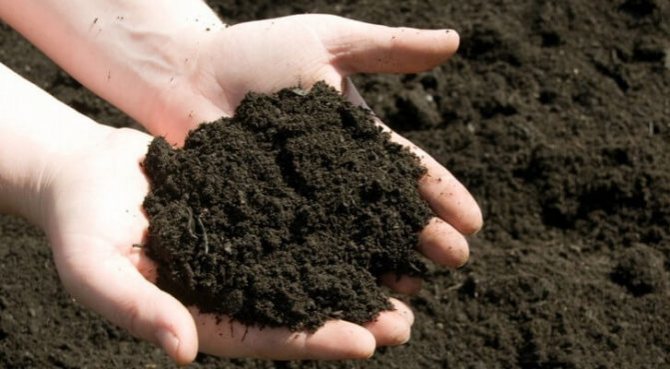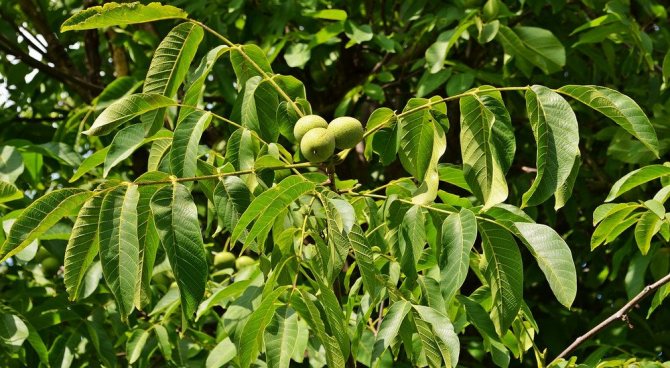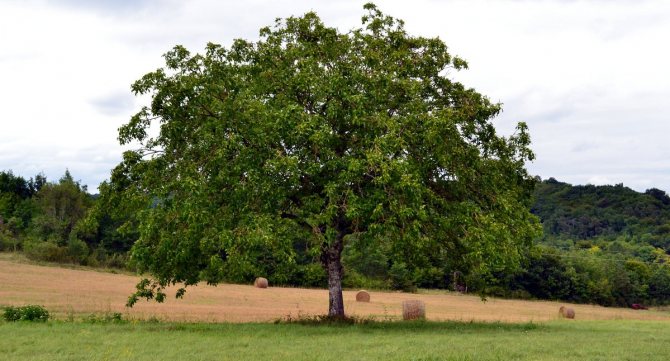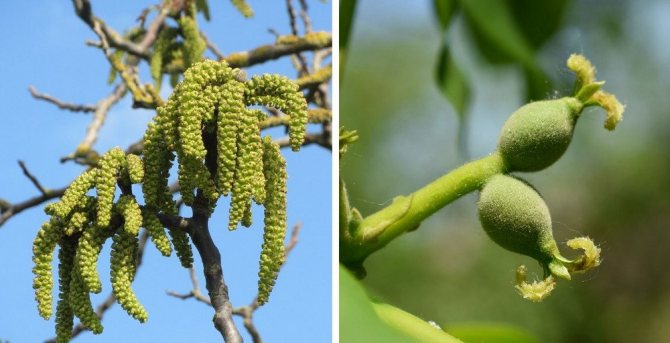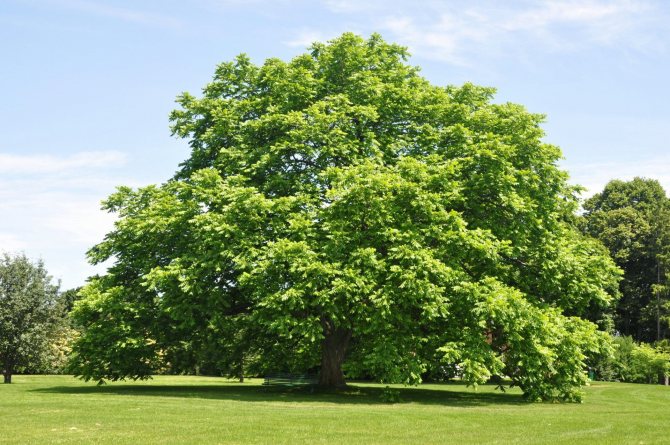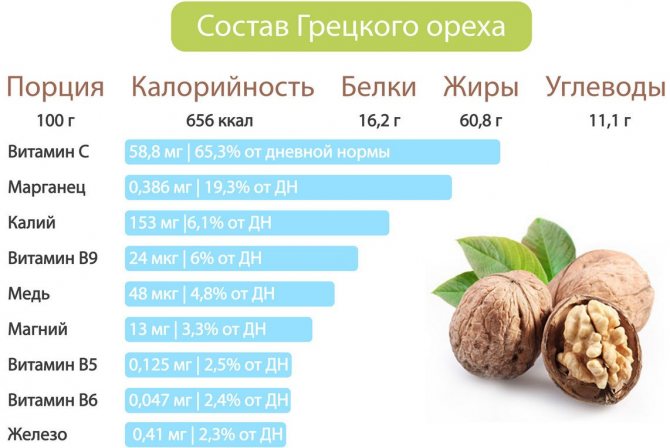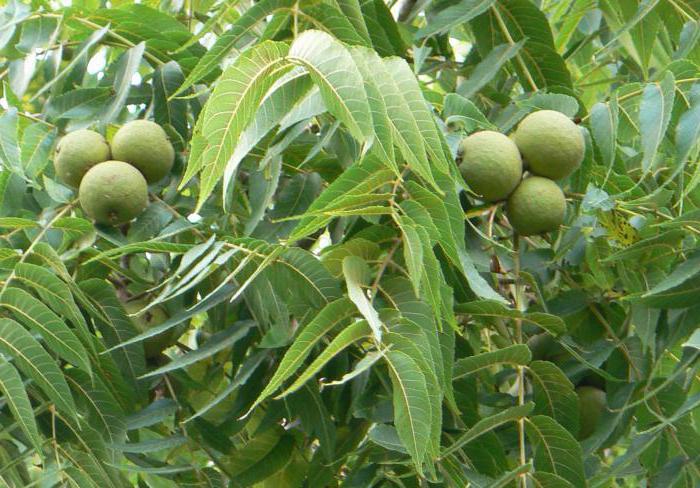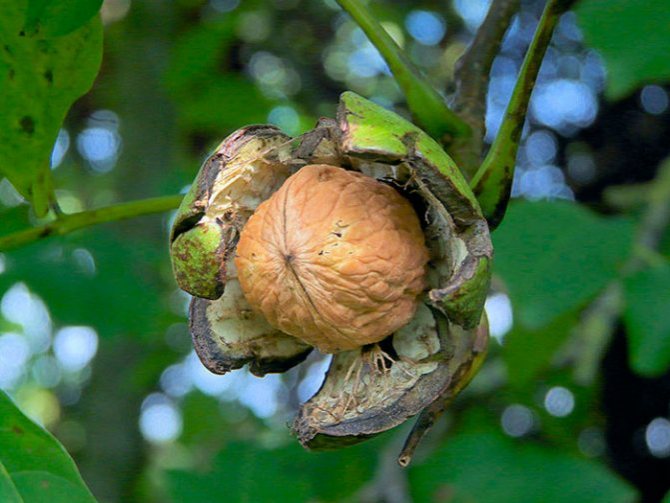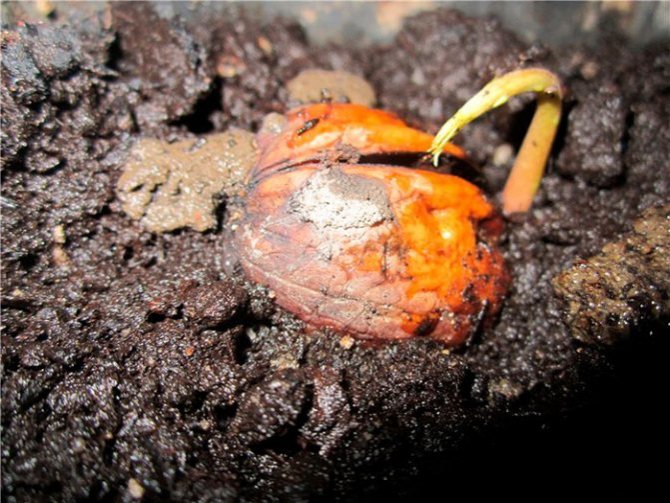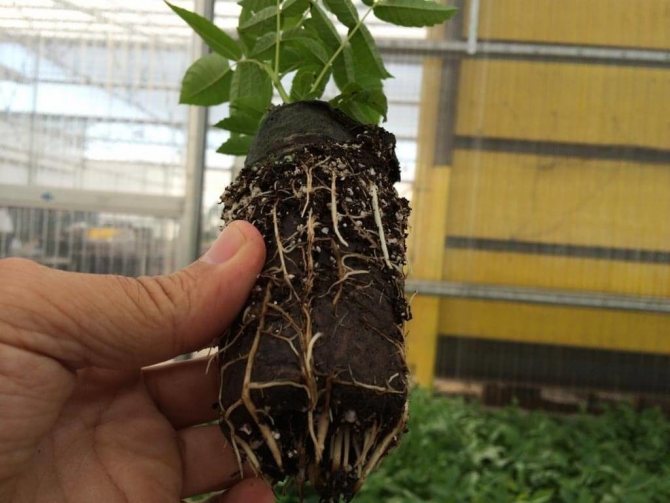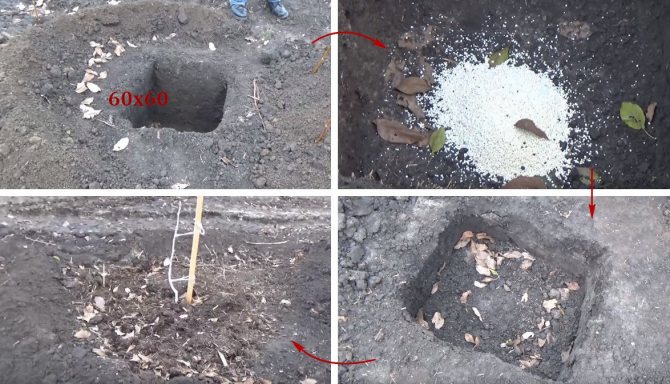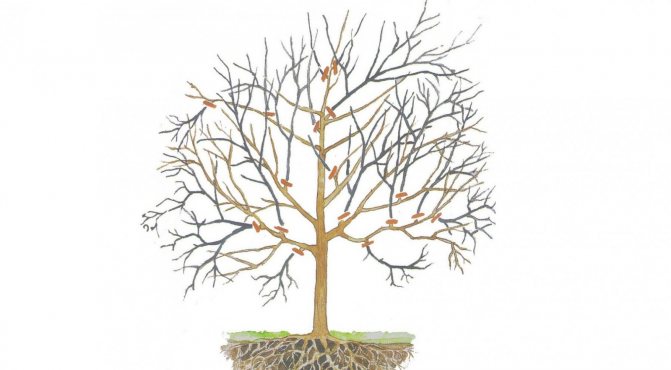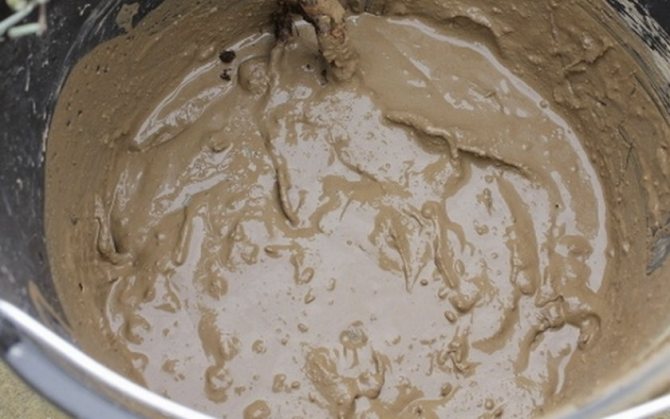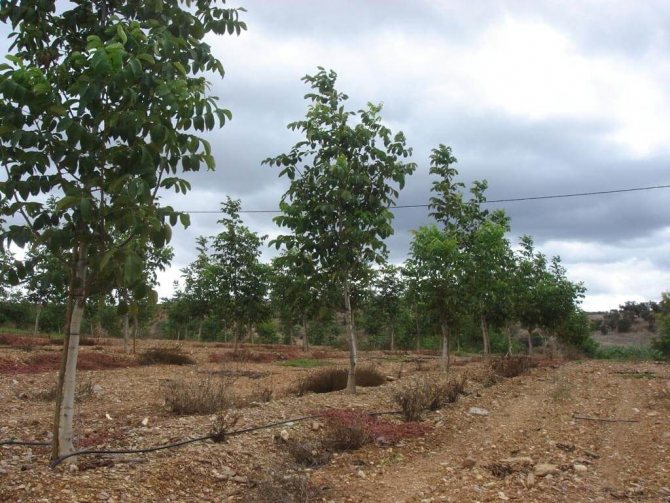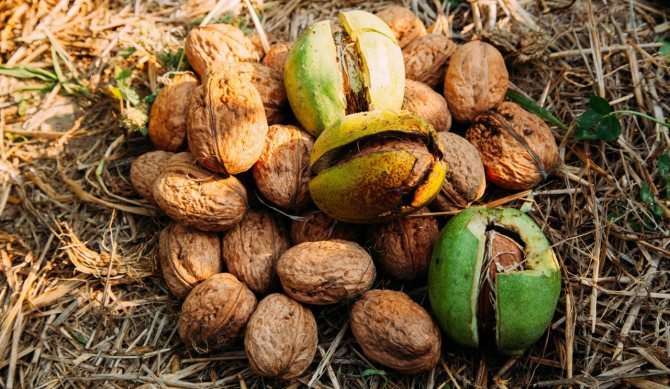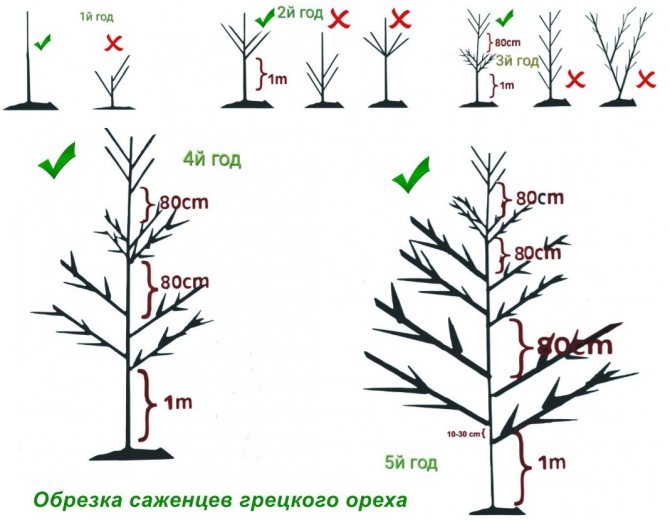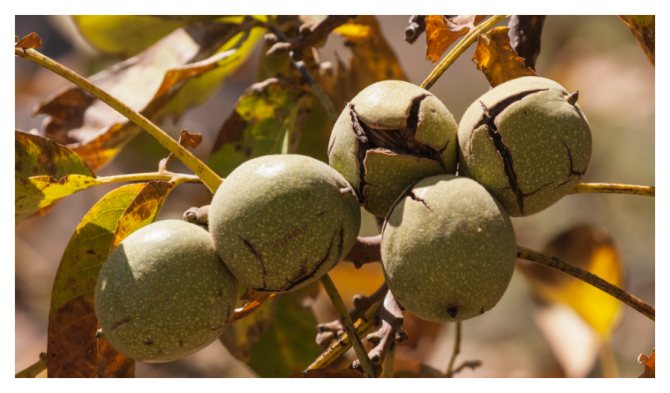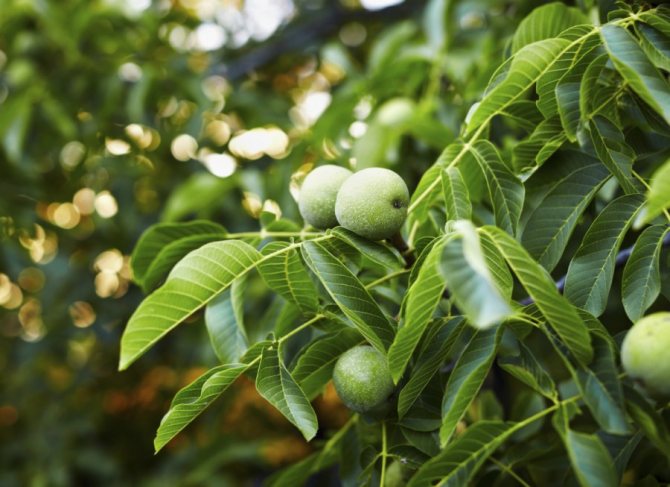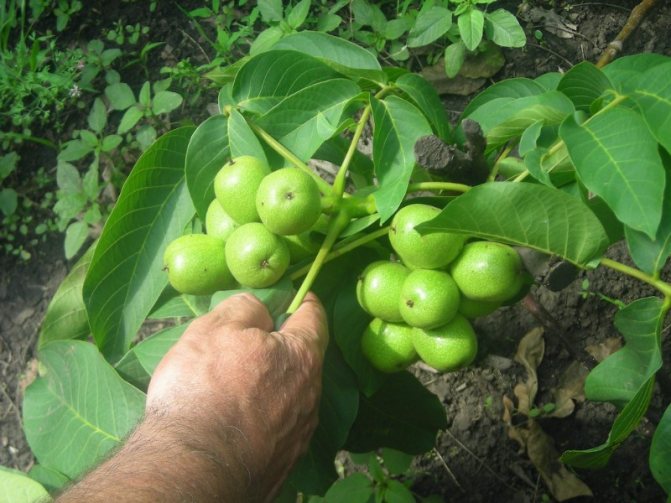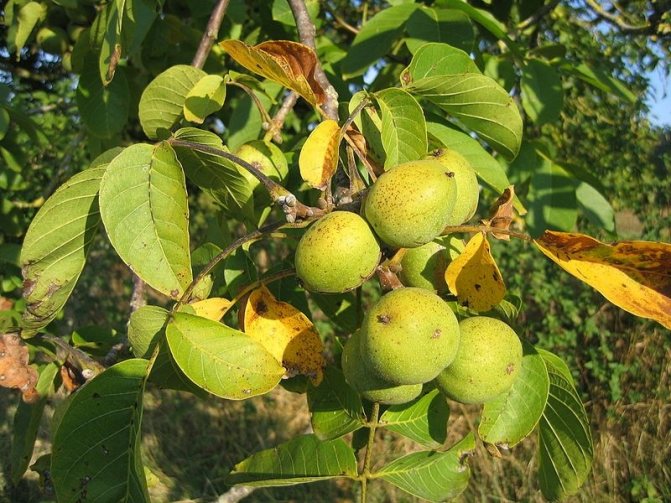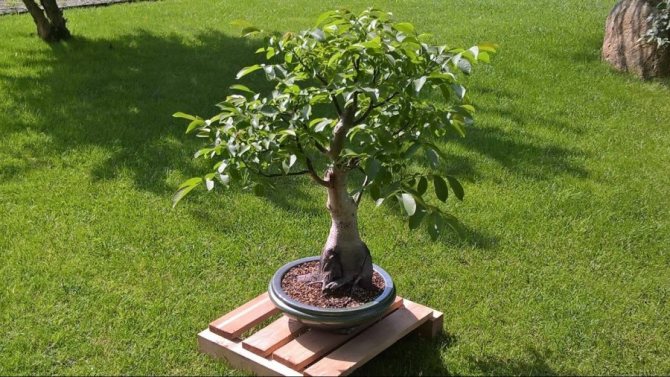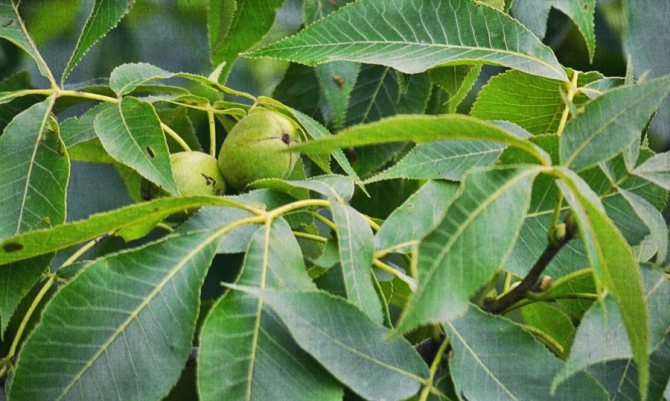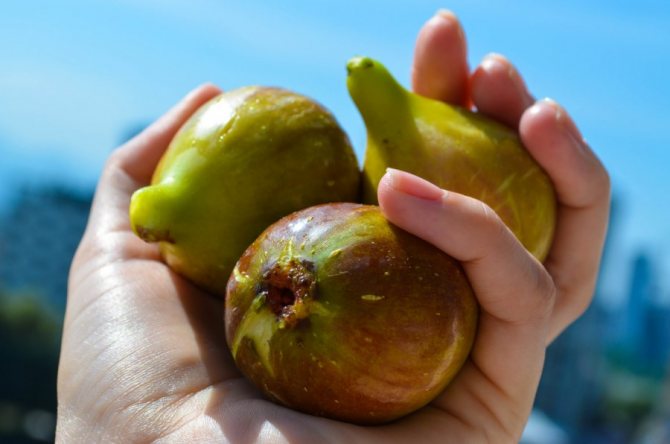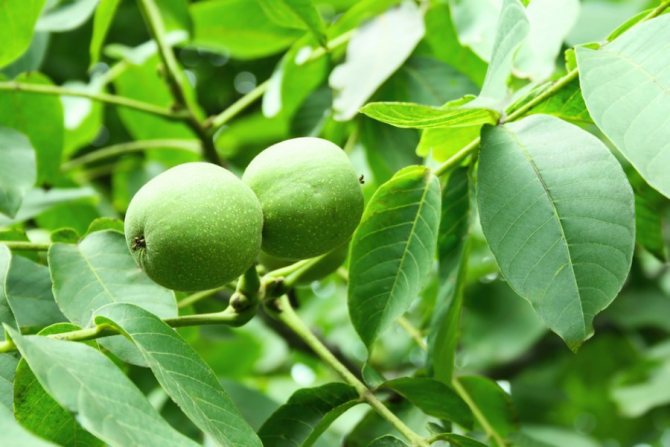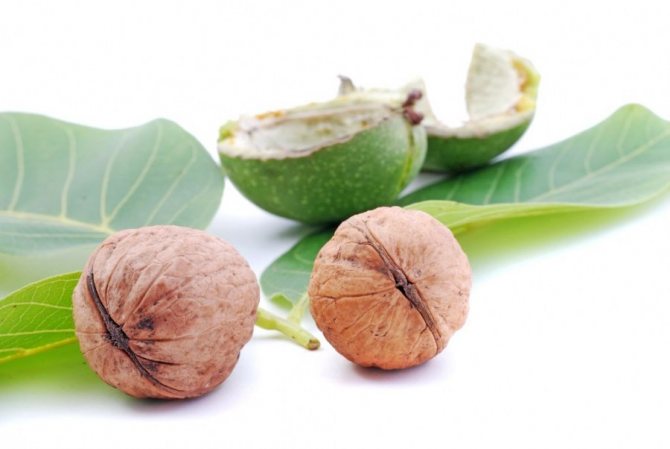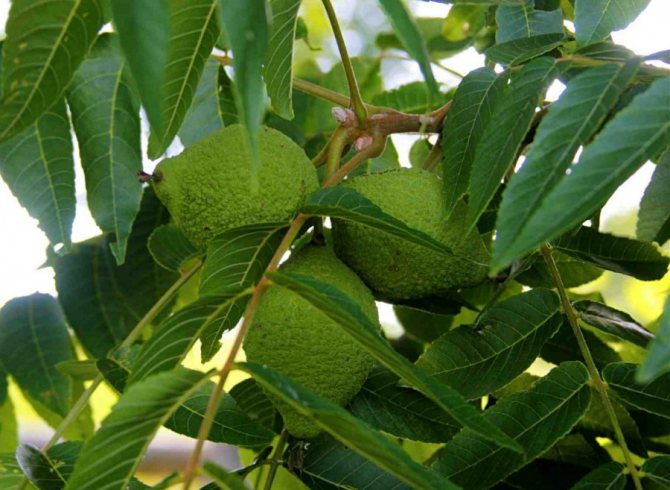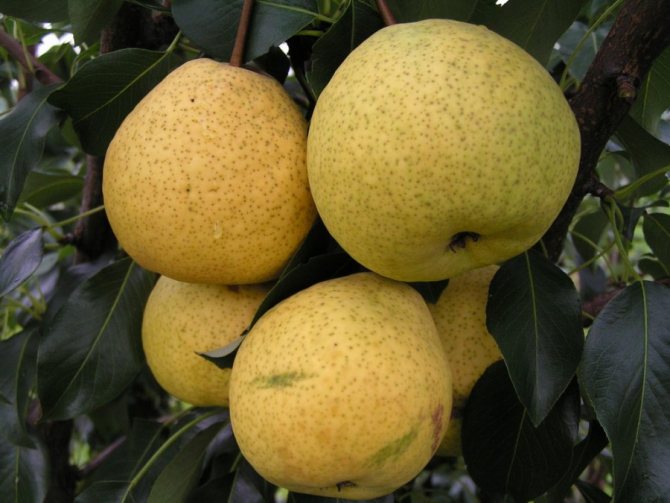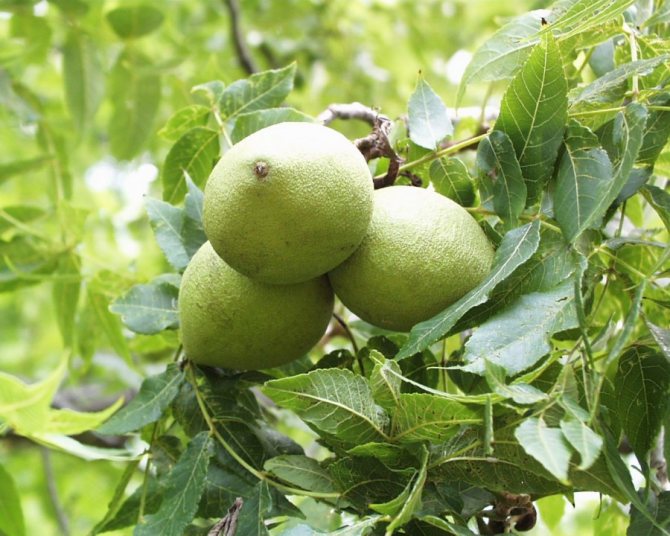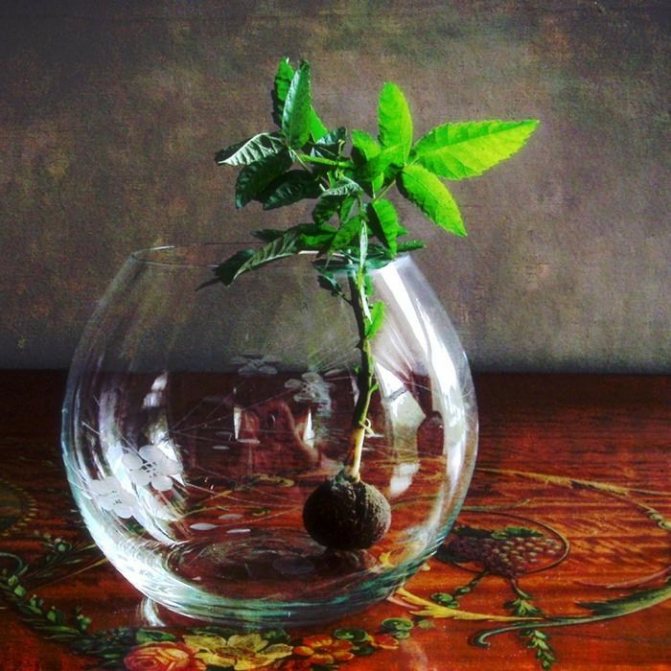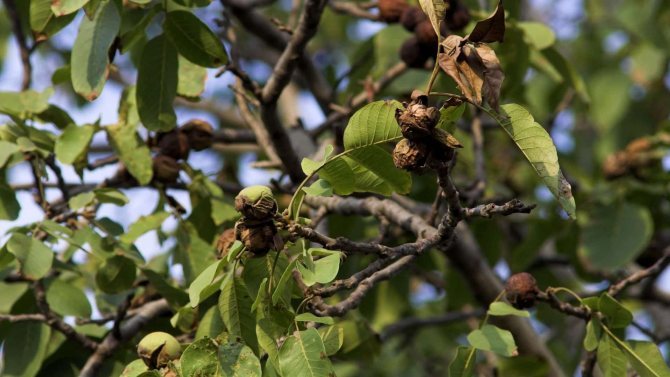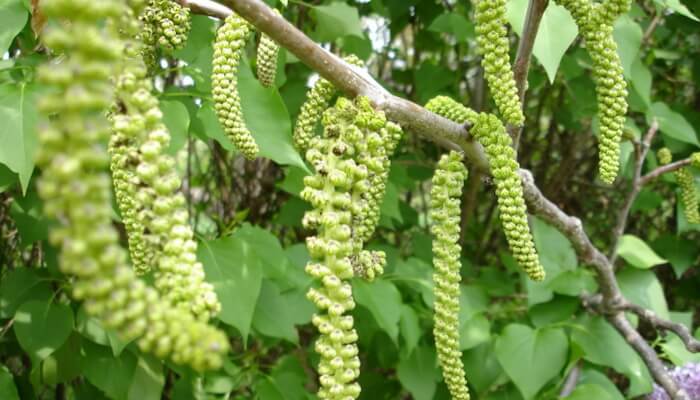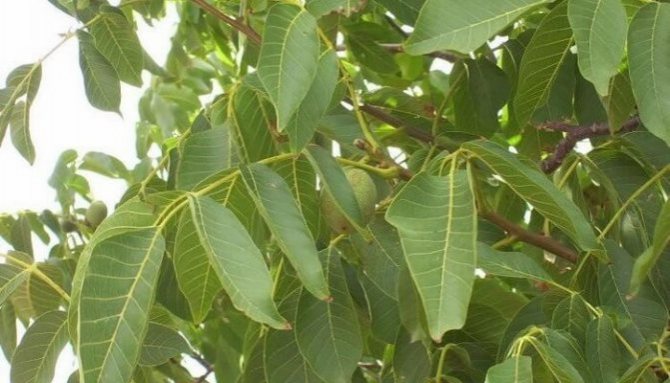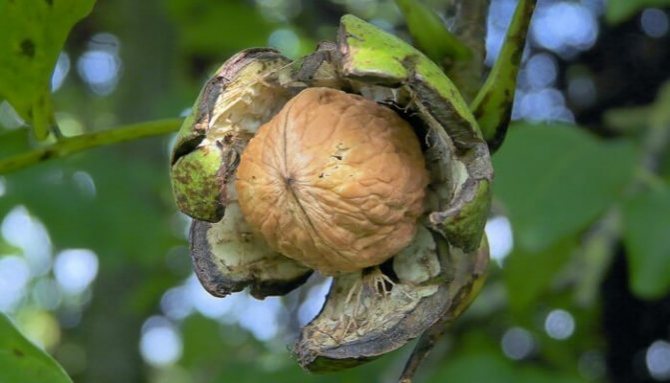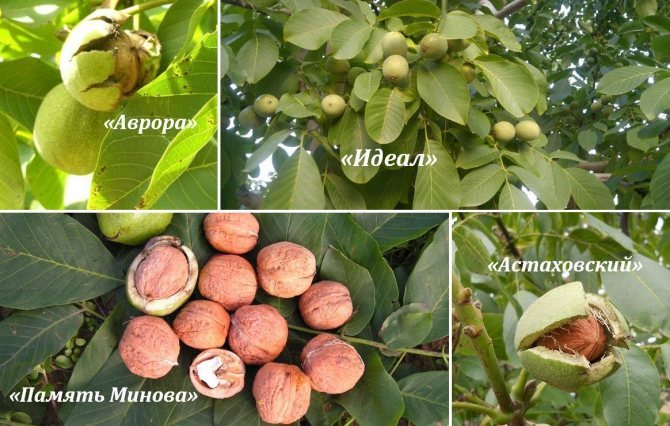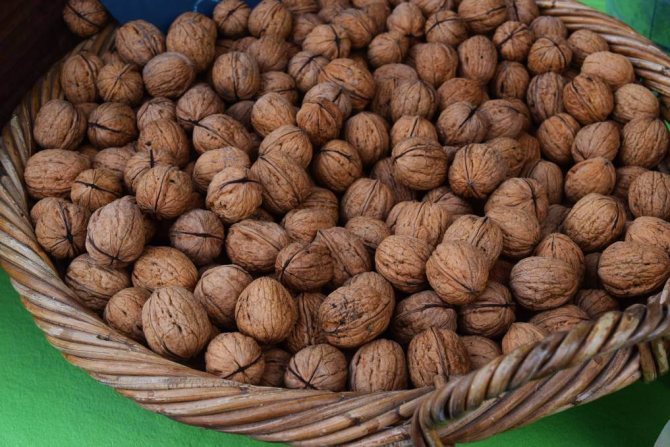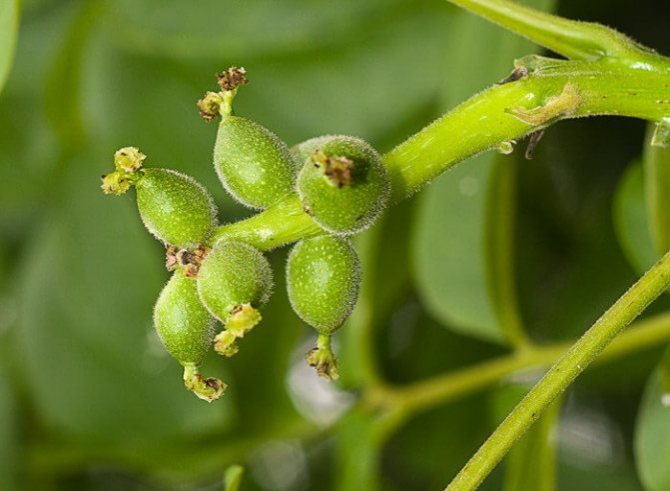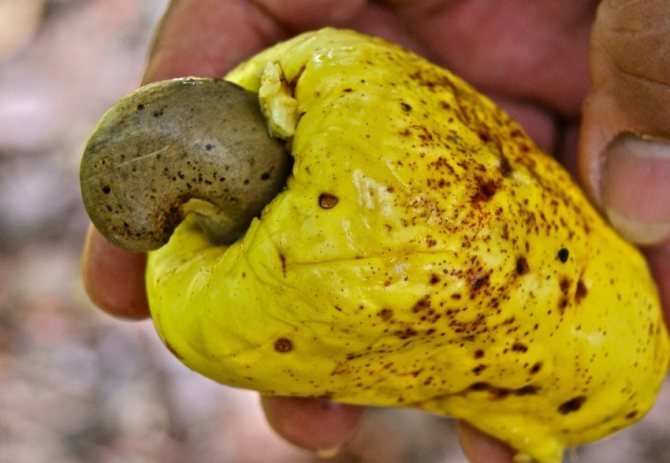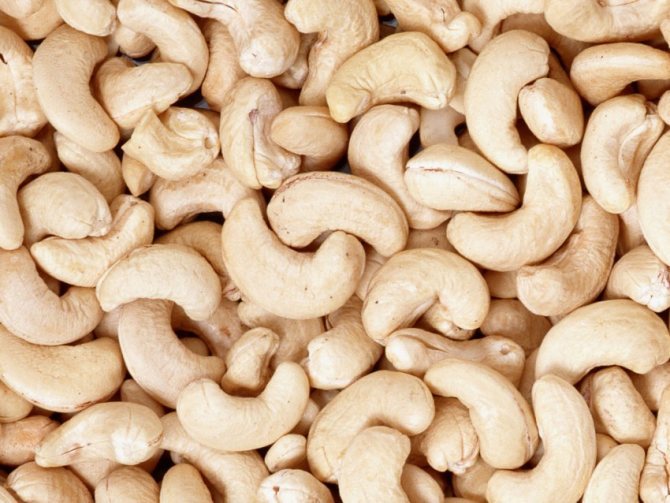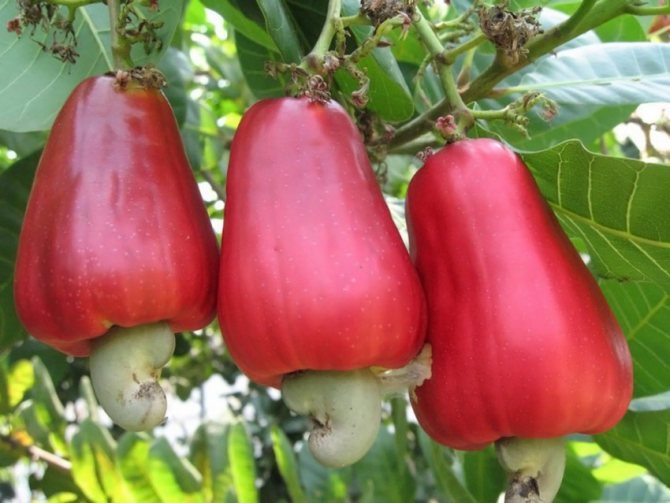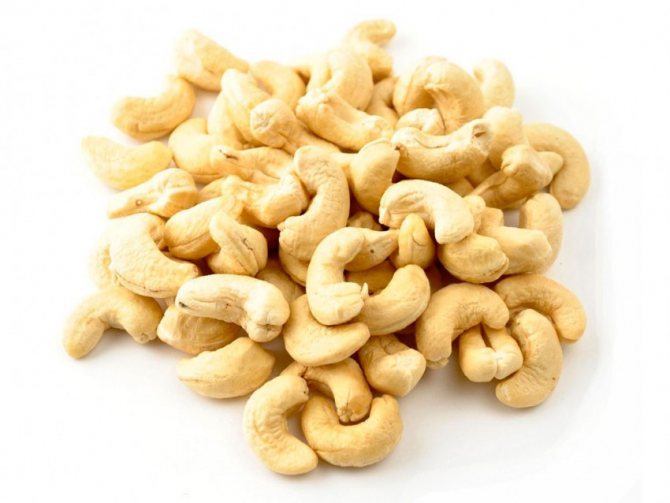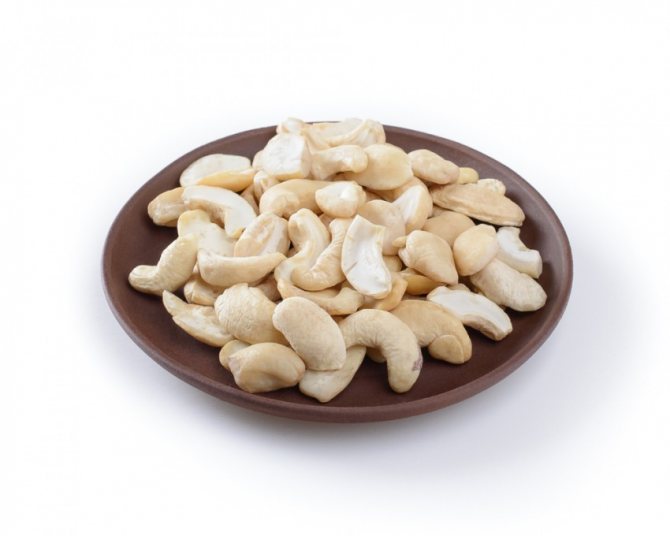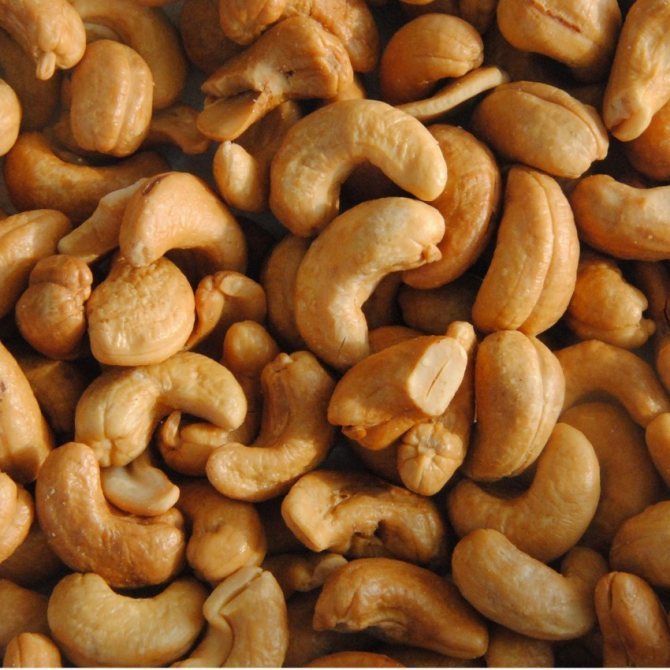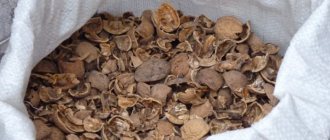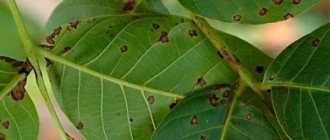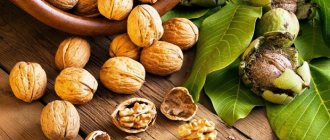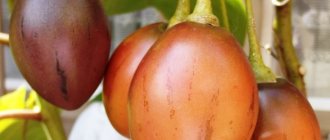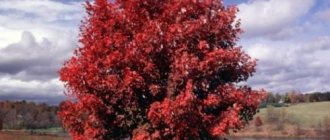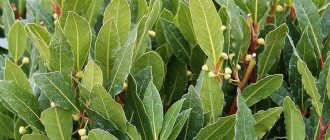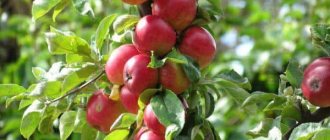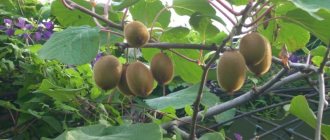Botanical description
Walnut is a tall, spreading tree. Specimens older than 50–70 years reach 25–30 m in height, and the diameter of their trunks in the lower part exceeds 1.5 m. The bark is dark gray, thick, covered with cracks. The root system consists of a powerful central rod, penetrating to a depth of 3–3.5 m, and adventitious shoots that develop after the tree reaches the age of 7–10 years. The crown is tent-shaped, dense. Leaves are petiolate, compound, pinnate, dark green with a bluish tinge. Consist of 7–11 elongated lobes with pointed tips, 8–12 cm long.
The flowers are unisexual, bloom simultaneously with the leaves at the end of April. Stamen and pistillate inflorescences are located on the same tree. The former are in the form of pale green hanging catkins, the latter are rounded sessile, with accrete perianths, growing at the tops of the shoots or in the leaf axils. Pollination occurs crosswise, since flowering is uneven on one crown.
The nuts ripen in September or October. Their sturdy woody shell is surrounded by light green fibrous pericarp, which burst on their own in the fall. Edible kernels are located under the ribbed shells in cavities separated by thin partitions. The mass of whole fruits is 6–15 g. The yield of kernels, depending on the variety, ranges from 40 to 68%.
The first nuts appear on trees at the age of 7-9 years. Plants reach full maturity by the age of 20 and continue to bear fruit up to 150-200 years. The lifespan of individual specimens exceeds the 500-year mark.
Walnut is not cold-resistant. Full cultivation is possible in regions where the average annual temperatures are at least + 10–12 ° C, and during the active growing season + 20–25 ° C. Adult specimens survive short frosts down to –25–28 ° C; during prolonged cold weather, the culture freezes out. In temperate climates, trees reach maturity and begin to bear fruit with the use of competent agricultural technology.
When to Harvest?
Look at the green pericarp to answer this question. Once they start to crack, the nuts can be harvested. After that, they should be kept in the basement for about a week - this way it will be easier to clean them of the blackened top layer. After peeling, the nuts should be rinsed with water and dried in the sun. If you have some of the fruits left on which the pericarp is not removed, then you can pour all of them in a heap and hold them in the sun for a while - this way they will ripen faster.
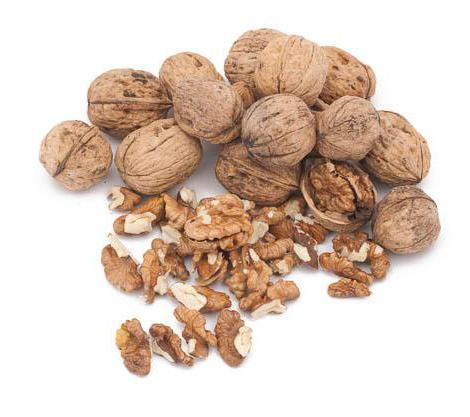
Application
Walnut is a valuable fruit crop. This determines the priority of its application. The number of nuts harvested from one mature tree of a high-yielding variety can reach 300–350 kg per season. Mature nuclei concentrate:
- 70–75% fatty oil;
- 20% protein;
- vitamins of group B, PP, E, D, carotene, ascorbic acid;
- iron, selenium, zinc, phosphorus, copper and other minerals.
Walnuts are highly nutritious food. They are used in cooking for the manufacture of a wide range of confectionery products, sauces, and national dishes.
Walnut oil has nutritional value and is used in pharmaceuticals and cosmetics.
The leaves and green pericarp of the plant contain bitterness, alkaloids, essential oils, tannins and other biologically active substances. It is a raw material for the production of skin and hair care cosmetics.
In folk medicine, preparations based on decoctions and tinctures of walnut greens are used in the treatment of infectious, gastric, dermatological diseases, to accelerate the healing of ulcers and wounds.
Crushed hard shells are used in the production of building materials, as abrasives. Pericarp and leaf juice is part of the dyes for the tanning industry.
Walnut wood is considered a valuable ornamental and joinery material. The massif is distinguished by a variety of shades: from grayish and golden-red to deep brown. The structure of the tree is fine-grained, with curled areas, pronounced texture and contrasting dark pattern. Density ranges from 500 to 720 kg / m³, toughness and shock resistance are moderate.
On an industrial scale, timber is not harvested, given the fruitful value of the crop. For this reason, the raw materials are mainly used for the production of veneer for furniture and finishing panels. Block parquet, armory boxes, interior items and souvenirs are made of walnut.
Beneficial features
Walnuts are useful as a natural source of vitamins, organic acids, animal fats, amino acids, macro and microelements. In terms of nutrient content, they are comparable to meat and dairy products, and in terms of energy value they surpass them by 1.5–2 times.
It is recommended to eat walnuts:
- children;
- physically weak and emaciated people;
- suffering from nervous disorders;
- with insufficient immune protection;
- pregnant women;
- with violations of the functions of the endocrine glands;
- with hypovitaminosis;
- with atherosclerosis;
- with heart disease;
- with helminthiasis.
Means based on nuts with honey and other additives are recommended in the treatment of hypogonadism, a decrease in potency in men.
Fatty oil, extracts of leaves and green walnut shells have bactericidal, regenerating, strengthening, choleretic, hemostatic, anticancer effects. Preparations based on them are effective for:
- liver diseases;
- bacterial and viral infections;
- intestinal disorders;
- varicose veins;
- tuberculosis;
- furunculosis;
- autoimmune pathologies.
Reproduction
For many gardeners of the Moscow region, the cultivation of walnuts is still a novelty. Plant propagation methods - seeds and grafting. Let's consider them in more detail.
Seed propagation
First, select seeds for planting, with preference for local varieties. They must be large, without any visible damage, and the core must be easily removed. Harvesting of seeds can be carried out when the green shell of the nut begins to crack. The nuts should be well dried indoors at room temperature.


Landing
It is necessary to place trees on sunny, level or elevated areas with loose neutral soil. For group plantings, the distance between the trunks should be at least 8 m.
The recommended planting time is spring. In case of insufficient nutritional value of the soil, its preliminary preparation is required.
- Pits for seedlings with a depth and width of about 1 m are dug at the end of September.
- Part of the excavated soil - its upper layer - is mixed with equal volumes of peat and humus, 2 kg of superphosphate, 2 kg of wood ash, 800 g of potash fertilizer, 500 g of chalk or dolomite flour are added.
- A pit is filled with a substrate, 20 liters of water are poured into it and left until spring.
Further work is carried out in April. The soil is taken out of the pit, a strong support 2.5–3 m high is driven into the bottom.The roots of the seedlings, before being placed in the ground, are dipped in a liquid chatterbox of 3 parts of clay, 1 part of rotted manure and water. At the bottom of the hole, 20 cm of drainage from small stones is pre-poured. Above - a mound of substrate. The tree is set in such a way that the root collar is 3-5 cm above the soil surface. Then the roots are sprinkled with earth on all sides.
Immediately after planting, the trunk is watered with 20-25 liters of water. When the moisture is absorbed, the seedling is tied to a support. The trunk circle should be mulched with sawdust in a layer of 2-3 cm.
Soil preparation
In the event that the fertile soil layer is rather shallow, it should be replaced or additionally fertilized. To do this, a large amount of manure is introduced, which is mixed with ash, and superphosphate is added. This composition is applied to a depth of 80 centimeters in the planting pit. In the future, with a favorable growth of the tree, every year it is necessary to change the soil along the width of the crown. In the prepared and fertilized soil, we make a hole 40 x 40 cm in size. To further stimulate the growth of young lateral roots, you can put a sheet of PVC film on the bottom of the hole. When planting, carefully spread the side roots horizontally and sprinkle them with fertile soil. The upper roots are left at a depth of about seven centimeters from the surface.
Care
Walnuts are picky about the level of moisture. In hot weather - from May to July - it must be watered twice a month, consuming about 5 liters per 1m² of soil. To collect and rationally use rainwater, it is recommended to surround the trunks with a 15-cm roller of soil or sand within a radius of 40-50 cm. In August, the frequency of watering is reduced to 1 time per month. With heavy rainfall, additional moisture can be dispensed with.
The roots of walnuts do not like loosening, therefore, all emerging weeds should be removed immediately, and the mulch layer should be regularly renewed.
In the first 3 years, the seedlings have enough fertilizers applied to the soil during planting. In the future, during the growing season, walnuts need:
- 8-10 kg of superphosphate;
- 2.5 kg of potassium chloride;
- 5 kg of nitrate;
- 7-8 kg of ammonium salt.
Nitrogen compounds are introduced in the spring and in the first half of summer. Phosphates and potash mixtures - from July to autumn.
Pruning of dried and diseased shoots is carried out in March, before the beginning of the growing season. They begin to form the crown when the bole reaches a height of 80–100 cm. This is done in October: the lateral shoots are cut, the skeletal branches are shortened by 10–20 cm. Pruners must be sterilized before starting work. Places of damage thicker than 5 mm are lubricated with garden varnish.
Gray walnut
Originally from North America, from the east coast of the United States and Canada, he is also no stranger to the ups and downs of the weather. Outwardly, it is very similar to the Manchurian nut, but a little lower - 15–20 m.
The leaves and fruits are also smaller. But the taste of the nuts is excellent - they are sweet and oily. The tree begins to bear fruit in the 10-15th year of life.
Gray walnut is very photophilous, it is better to plant it in open areas, in fertile soil. It grows quickly and is resistant to frost. Prophylaxis against tinder fungus is needed.
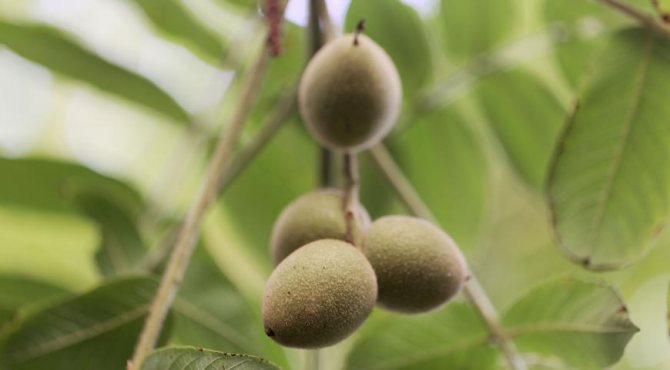

Diseases and parasites
Gray, brown, black spots on the foliage, fruits and shoots of the walnut are signs of bacteriosis or marsoniosis. Prolonged dampness, improper watering, excess nitrogen fertilizers can lead to them. For the prevention of diseases, it is necessary to monitor agricultural technology. In the spring, you need to free the trunks from dead bark, freezing branches, treat trees with a 1% solution of vitriol or Bordeaux liquid. Affected plant parts - cut and burn. To prevent the development of mycoses and scare off pests, regular treatment of trees with a 7% aqueous solution of urea helps.
Growths on the trunks are symptoms of root cancer.Such neoplasms need to be opened, cleaned with caustic soda and rinsed with plenty of water.
The annual whitewashing of the trunks with lime to a height of 1–1.5 m from the ground helps to protect the bark from parasites. To get rid of aphids from trees, you need to spray the crowns with Actellik or Antitlin preparations.
Moth caterpillars and their nests must be collected by hand, and special traps must be hung on the branches. The larvae of white butterflies are destroyed with a 30% solution of Dendrobacillin, spraying the crowns outside the flowering period. When plants are damaged by a nut mite, acaricides are used - Aktar or Kleschevit.
In a temperate climate, the fruiting age of a walnut occurs 2-3 years later than in the south, and the yield is an order of magnitude lower. However, with proper care, spherical carved tree crowns will become the main decoration of the garden.
How to fertilize correctly
In addition to choosing the most suitable type of fertilizer for hazelnuts, its correct application, taking into account the type of soil and its moisture content, will be equally important. In order not to burn the root system of trees and shrubs, it is better to plant organic mixtures only in moist soil, retreating from the central trunk of the hazelnuts by at least 20 cm.
After fertilization with humus or compost, the soil surface should be watered again and mulched with a layer of peat or sawdust, which should prevent the substrate from drying out quickly and ensure long-term nutrition of the roots with the used organic matter.
Another possible way of fertilizing hazelnuts would be the introduction of rotted manure for the main plowing, spending 3-4 kg of pure humus or 1.5-2 kg of the same organic matter per 1 m2, but with the addition of phosphorus-potassium fertilizers (about 20-30 g per 2 kg).
Organic feeding of hazelnuts will be especially relevant when it is planted on the slopes of the site, characterized by a small amount of humus. On very depleted soils, nitrogen-containing compounds should be used only in spring, so as not to provoke an intensive growth of green mass to the detriment of fruit formation of the culture and a decrease in the general frost resistance of young shoots.
Important! When planting cut green manure plants into the ground, make sure they are healthy and free of pests. It is better not to use plant parts damaged by insects, as they can become a source of infection for healthy hazelnuts.
As for the fertilization of hazelnuts with mineral compounds, they are usually dissolved in an irrigation liquid and poured together with it into a hole organized in a circle.
In the aisles of young hazelnut plants in the first two years of its cultivation, it is also useful to plant vegetables and melons, but they should be placed at a distance of at least 1 m from walnut bushes.
How exactly to feed your hazelnuts - each gardener can decide on his own, the main thing is to do it taking into account the type of soil, its initial fertility and the state of the plant in different seasons (spring, summer, autumn). Having paid maximum attention to feeding the culture, one can hope for its same generous return in the form of healthy nut fruits.
General characteristics of the tree
Walnut is mainly found in most of the European territory of Russia, in the southern, central and eastern regions of Ukraine, in the southern part of Kyrgyzstan. Iran is considered the birthplace of the tree, but many believe that it comes from China, Japan or India.
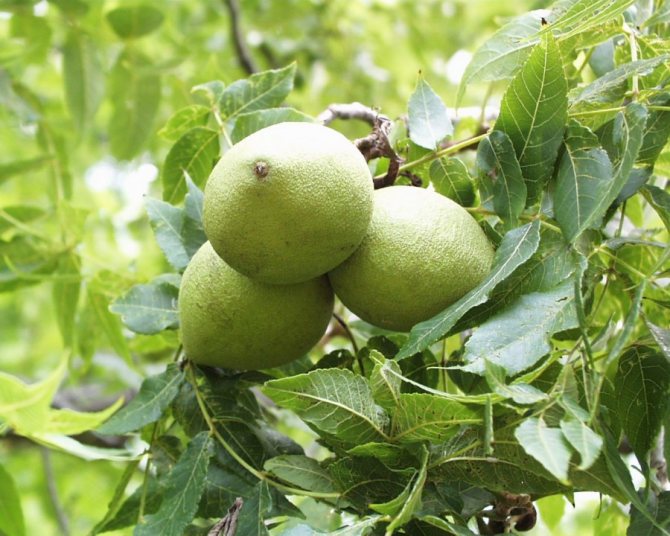

The walnut is a large tree, reaching a height of up to 20 meters. The trunk diameter of large varietal trees is more than 6 m.
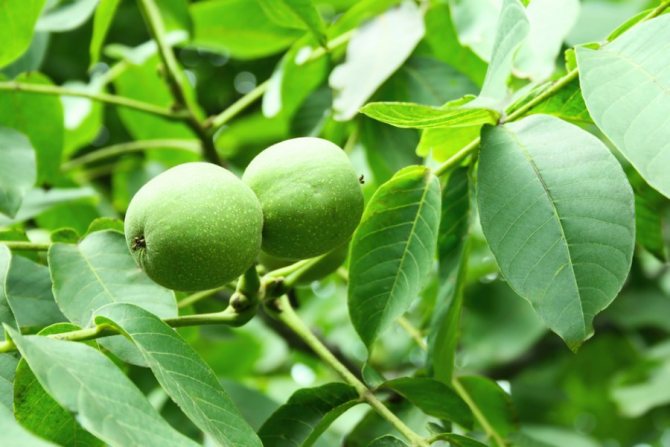

Walnut branches with large elongated leaves form a dense large crown, under which sunlight practically does not penetrate. The size and shape of the fruit depends on the variety and growing conditions (you can see this in the photo of the nut in our gallery), the weight of the nuts is from 5 to 20 g.
Walnuts are well-known centenarians. They can live quietly up to 4 centuries, and age has practically no effect on their productivity.
In order for the yield of the plant to be consistently high, certain rules for caring for the tree should be followed, and you should know how to protect the nut from potential pests. You should also familiarize yourself with what varieties of trees are best grown in garden plots, whether you need to prune the tree, how to collect and store the harvested nuts.
Spread
Everyone knows how walnuts grow. The homeland of the plant is considered to be Central Asia, the Caucasus. Wild thickets of plants are found in Asia Minor, Iran, Afghanistan, the Balkan Peninsula, Among the mountains of Tibet, Transcaucasia, many places on the planet. On the territory of Kyrgyzstan, along the slopes of the Fergana, Chatkal ranges, Jalal-Abad region, wherever walnuts grow, relict forests of various types of nuts have been preserved. As a cultural planting of the Caucasus, the tree has been known for a long time. For its beneficial fruits, the tree is cultivated in numerous areas. In this case, it is taken into account that the walnut tree freezes out at temperatures of about 28 degrees below zero. The soil is chosen fertile, moderately moist. With good breathability. The tree successfully tolerates drought due to its root system, which occupies a large area, penetrating into the ground. By the way, the most northern tree is called a walnut growing in the Norwegian city of Försund, and its main suppliers are China, Turkey, America. Among the countries of the Soviet Union, Moldova occupies a special place in terms of the volume of plant cultivation. Namely, this is the origin of the ancient custom of planting a tree when a child appears in a family.
Many countries grow walnut tree plantations on an industrial scale. Their creation is based on knowledge of agrotechnical methods of cultivation in their climatic zone. The main points in this case are considered to be the correct choice of a variety that is optimal for obtaining rich fruit yields. Among the numerous varieties, there are very many low-value plant species that give low yields. So, for the creation of economic plantations in Ukraine, Belarus, Russia, breeders obtained about 21 plant varieties with pre-planned characteristics and qualities. Such as resistance to widespread infection with diseases, low temperatures. high productivity. The most fruitful winter-hardy types of nuts are Suzirya, Sadko, Porig.
Manicured plantations of the majestic forest where walnuts grow in Russia make it possible to profit from various parts of the plant. It:
- Kernels of nuts. They are distinguished by good taste. Used in human nutrition. This is a favorite since childhood halva, cakes, pastries. Other equally nutritious dishes from kitchen recipes from different nations. The ancient population considered nuts to be an effective antidote, helping with the action of many poisons. It was recommended to eat two nuts every morning along with wine berries. On some islands of Scotland, from nuts, which have a white shell color, they made amulets from damage in the form of a children's necklace. Kernels contain about 65% fats, 20% easily digestible proteins, numerous vitamins, microelements. Traditional healers have long used the healing properties of tree parts to treat diseases.
- Leaves. Traditional healers have tested numerous proposals for infusions in the treatment of gastric, gynecological diseases. As a general tonic, depletion, vitamin deficiency. The amount of vitamin C contained in May leaves is no less than in rose hips. They are harvested in early June and are used in dermatology and cosmetology.
- Wood. Beautiful interior items, furniture, doors are made from it. For a long time, there has been an interesting trade among the population of the Caucasus in the form of removing growths from a walnut trunk. Huge pieces of wood were sold at a bargain price, which was determined by the presence of a decorative moire pattern. They are well processed and polished.This often led to the untimely death of the plant.
- Unripe fruits. Their advantage lies in the high content of vitamin C, which makes up twice the daily requirement of a person. This is no less than the vitamin content in rose hips, black currants, lemons. In addition, green pericarp contains a large amount of tannins, coumarins, quinones, substances with bactericidal properties. The harvesting is done in August. Often they are used to prepare special vitamin concentrates. The most accessible is the green walnut jam. By the way, I.V. loved him. Stalin. Tincture of unripe fruits was made from slices drenched in vodka. She was insisted for about two weeks in a warm, sunny place. The tincture was poured off, the fruits were covered with sugar, and kept for almost a month. The resulting liqueur was used during the treatment of diseases of the intestines, stomach, taking two teaspoons daily.
It is possible to provide the required amount of nuts only through cultivation on plantations. First of all, they are created under conditions of optimal natural growth with the required climatic conditions.
Most often, large-fruited and early-fruited forms of walnuts are grown. The group of early-growing species was discovered later than other forms. Their difference is the entry into the fruiting period much earlier. Some varieties give the first harvest already in the second year of development. They are characterized by secondary flowering. Throughout the growing season, the tree is decorated with fruits of varying degrees of maturity, flowers. The height of early-growing varieties is only 10 m, which greatly simplifies harvesting. Their disadvantages include a decrease in life expectancy to 40 years, instead of 400.
Among the varieties of walnut, Ideal, Izobilny, Urozhainy, etc. are most often grown.
How to plant a walnut
In most cases, the optimal time to plant a tree is in spring. But in the southern regions with light frosts and mild winters, autumn planting is also possible.
The selected area must be sufficiently sunny, otherwise the seedling will begin to ache and may die. It should be borne in mind that no other trees, bushes or flowers should be planted near the planting site.
Growing, the crown of the nut completely shades the ground under it, so all green spaces without sunlight will simply die over time. For example, the diameter of the crown of an adult 30-year-old tree is about 12 meters, which continues to increase with the age of the tree.
It is also worth considering the possibility of planting 1 or 2 more walnut trees of a different variety on your site. Such a neighborhood will contribute to better pollination of trees.
If planting is planned in the spring, then the planting hole for the seedling should be prepared six months earlier, around October. The diameter and depth of the pit depends on the size of the root system, so in the fall it is necessary to do it with a small margin, and in the spring, during planting, the size of the depression can be adjusted.
Typically, the pit should be at least a meter wide and deep. It is recommended to put a thin layer of soil mixed with humus and complex fertilizers at the bottom of the recess. You can also put wood ash in the hole and cover everything with leaves. By the spring, the groove will be the perfect nutrient mixture for the root system of the young walnut.
In the spring, before planting, the seedling must be inspected, damaged, rotten or dry roots must be removed. Immediately before planting a seedling in the ground, it must be lowered for 15-20 minutes in a special "talker". It is not difficult to prepare it: you need to take a little water, 1 part manure and 3 parts clay. Mix everything, the consistency of the "talker" should be like liquid sour cream.
In addition, a little growth stimulant should be added to the solution. Such a mixture will help protect the roots when planting the plant, the tree will take root and grow much faster.
It is very important to create optimal nutritional conditions for a young seedling - at first, while the tree is just rooting and taking root, the soil 1 meter in diameter around the root will be the main source of its nutrition.
After planting, it is recommended to compact the soil well and water it with water, at least 2 buckets. After the water is completely absorbed into the ground, shredded dry or fresh grass, an additional layer of humus or peat should be placed around the trunk. Mulching is necessary to retain moisture in the ground.
When planting a seedling in the warm regions of our country in autumn, the rules for planting in open ground differ little from the rules for spring planting. It is necessary to prepare an autumn planting pit not six months in advance, but only 2-3 weeks before transplanting.
Fruit
Today, many gardeners from different regions of our country can hear: "We grow walnuts in the country." And this is not surprising, because the fruits of the tree in question, which are a false drupe, are the most valuable food product.
The outer pericarp is light green and has a flat surface. When the nut is fully ripe, the pericarp turns brownish brown or black. Its function is to protect the nut-seed.
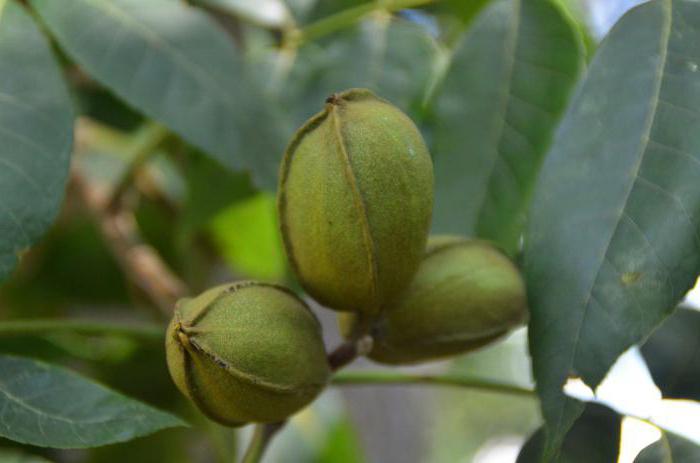

The plant blooms, as a rule, in April-May. The fruits ripen completely at the end of August. Outwardly, the kernel of a nut resembles a human brain. It contains many valuable nutrients - at least 65% fats, carbohydrates, proteins, minerals and tannins, a huge amount of vitamins (B, A, C, B2 E, K, P and others). The chemical composition of the nucleus includes a wide range of amino acids.
Varieties of walnut
Modern breeders have bred many varieties of walnuts that are distinguished by good yields, as well as resistance to cold weather, diseases and pests. There are trees with early, mid-ripening and late fruits. For more northern regions, it is recommended to plant early nuts, which ripen in early September.
- Variety "Skinoskiy" is a walnut tree with an early ripening period. Fruits are ovoid, large with a thin shell.
- Sort "Selektsioner" is a cold-resistant fruitful variety of walnut. Regular, stable fruiting.
- Variety "Prykarpatskiy" - loves sunlight and moisture. The tree gives a good harvest already in 5-6 years.
- Ideal is a large, oily fruit that can be harvested in October. It has thin internal partitions that do not interfere with easy cleaning of the walnut.
In addition to all of the above, it should be noted that not only its fruits are valuable in the tree.
Walnut is one of the most expensive types. It has a noble dark shade and is often used for the production of expensive furniture.
A natural dye for fabrics is produced from the juicy leaves of the tree. Also, the leaves are often used by beauties to prepare a useful decoction for rinsing hair.
The walnut tree has long ceased to be exotic in the gardens of our regions. In general, growing and caring for a nut is simple and does not take much time and effort. In gratitude for the care and attention, the tree will generously shower the earth with its fruits every autumn.
The best varieties
There are walnut varieties that are most loved by the inhabitants of Russia.
These include:
- "Aurora" - not afraid of frost, the variety is resistant to many diseases. Has a core mass of 12 g;
- "Ideal" - a frost-resistant, early-growing variety that can withstand temperatures as low as -35 ° C. Repeated flowering is possible with the appearance of a large number of nut ovaries;
- Astakhovsky - frost-resistant (tolerates a drop in temperature to -37 ° C), has good resistance to pest infestation. Included in the State Register of Russia in 2015. Suitable for growing in the Voronezh, Kursk regions, in the Central regions of the Russian Federation. Also planted in the Samara, Penza, Ulyanovsk and Orenburg regions.The kernel has a dessert taste rated by professionals at 5 points;
- "Memory of Minov" - a fast-growing variety with a powerful crown, has a large fruit (fruit weight 15–18 g) walnut of medium ripening. Withstands temperatures as low as -37 ° C;
- "Elegant" - medium early variety, drought-resistant. May not tolerate severe frosts. Bears fruit in 5 years.
- "Levina" - undersized, early-growing variety, characterized by increased frost resistance. When the temperature drops to -35 ° C, it may freeze slightly. Resistant to pests and diseases.
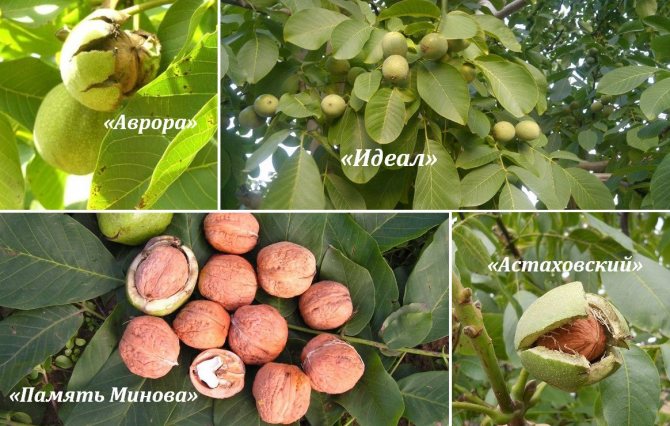

The Greeks called walnuts karion, which means "head". This is because the shell of a walnut resembles a human head, and a nut kernel looks like a brain.
How walnuts bloom
The tree blooms from April to May. Walnut bloom lasts about 15 days. At the same time, both female and male flowers can be on it. Females are located at the top of the annual shoot singly or in several pieces. Male stamens look like hanging earrings, tightly gathered in the axils of the leaves. Below are a few photos of walnut flowering.
Walnut flowers are small, light greenish. Pollinated by wind and pollen from other walnut trees within a radius of 1 km. As a result of pollination, fruits are formed.
Fruits are large nuts with a thick green peel 0.5 - 2.2 mm thick and a dense pit with several partitions. When the fruits are ripe, the peel dries up and breaks into 2 pieces. What remains is a woody shell, inside which the edible kernel itself is enclosed. Maturation occurs in August and September. Nuts can be both small and large: it depends on the variety and place of growth of the tree. The shape of the fruit is usually round, oval or ovoid.
After planting from seed, fruiting occurs at 8 - 12 years. From 10 to 300 kg of fruits are obtained from one tree annually. On a garden plot, walnuts live for about 200 - 500 years, in the wild - up to 1,000 years, and sometimes even longer.
Important! The older the individual, the more harvest it can bring. A large yield is also characteristic of trees located far from others.
Growing regions
A long-term walnut can live for about 200-500 years if grown on site. The tree grows in Central Asia, Iran, in the Caucasus, where it first appeared 8 thousand years ago. In the wild, the age of a walnut can reach 1,000 years.
Japanese Cryptomeria Home and Garden Care
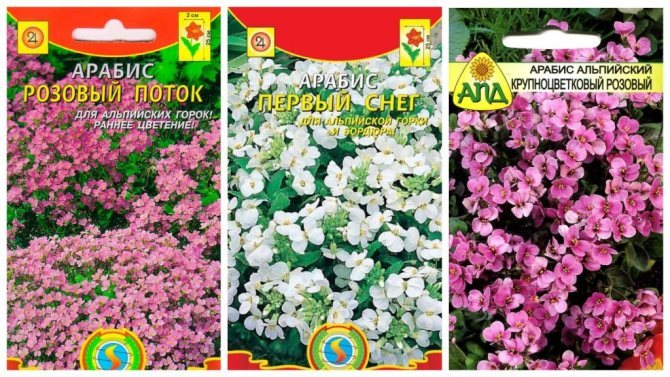

Wild walnut often occupies northern, western and eastern mountain slopes, gorges, river valleys. The tree occupies a height of 1.5-2 km above sea level on the slopes. There are small groups of nuts, freestanding individuals, groves - in rare cases.
The cultivated plant grows in India, China, Greece, Japan, Transcaucasia, Asia Minor and Central, Ukraine and Western Europe. In Russia, the nut grows in the Krasnodar and Stavropol Territories, in the Kuban, in the Rostov Region. Plants hardly tolerate the harsh climate of the northern regions of Russia, but the cultivation of cold-resistant varieties is widespread.
In central Russia, varieties of walnut imported from eastern Ukraine, the Caucasus or the Central Asian mountainous region are being mastered. The European part of Russia is more convenient for growing a plant, therefore culture is found over a large areafrom the foothills of the Caucasus to St. Petersburg.
Why walnut does not bloom
To grow a nut that can enter the fruiting season, you need to properly study the biological characteristics of the flowering of this plant.
Variety and method of planting
There are early, medium and late fruiting varieties of varieties.To quickly achieve the color of a walnut, you need to know the heredity of the individual from which the seeds or cuttings were taken.
Advice! A seed-grown plant begins flowering much later, at 8 or 17 years of age. A plant grafted with cuttings blooms from 1 to 5 years.
Absence of a partner
It is known that the walnut is a dioecious plant, however, its flowering has three forms.
| Protandric | Protogonic | Self-fertile |
| First, a male flower blooms, and after a certain time, a female one. | First, the female is dissolved, and after that, the male. | The flowering of female and male inflorescences begins at the same time. |
| If the female inflorescences have not opened by the time the male ones have released the pollen, the tree will not bear fruit. | If the male flowers have just blossomed, and the female ones have already faded, there will be no harvest. | The plant self-pollinates and can subsequently bear fruit. |
Protandric and protogonic individuals are simply not able to fertilize on their own; during flowering, they need a pollinator.
Too much fertilizer
If the tree is actively growing, but flowering does not occur, this means that the owners fertilize and water it too generously. This contributes to the onset of enhanced root development, and other processes are inhibited or stopped altogether.
Abundant crown density
If the tree has a lot of sparse, short young shoots, it is too thick. Walnut blossoms occur with a moderate crown density. This way the pollination process proceeds better, since the wind can freely capture and move the pollen.
Unsuitable conditions and illnesses
Pollination of walnuts is impossible at both low and extremely high air humidity. Especially if there are prolonged cold rains during flowering.
Growing soil is also important. Walnut does not like acidic environments, and the most productive trees are found on lime-rich soils.
Among other things, flowering does not occur, because the tree can be sick or be infected with parasites.
Cashew
Cashew nuts grow on trees, the fruits look more like an unusual fruit than a nut. Initially, nuts grew only in Brazil, today they are cultivated in Central and South America, India, Southeast Asia and many other countries.
Read here - How to graft a pear: step-by-step instructions on how to graft a tree correctly. Vaccination tips for novice gardeners (90 photos)
There is poison on the walnut shell, they need to be heat treated, only after this manipulation does the nut go on sale.
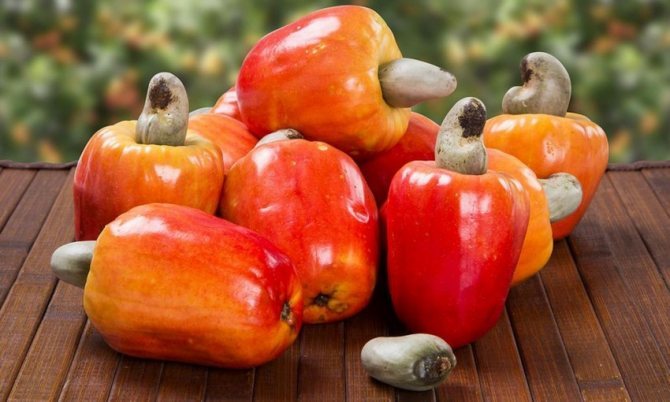

What to do if a walnut does not bloom
- To accelerate the time of fruiting, inoculate the individual with the "eye" of another walnut, similar in flowering cycle.
- If the walnut tree is not self-fertile, plant a partner with it. It must be selected in such a way that the ripening periods of male and female flowers coincide in plants.
- Another option is to use a branch from another plant with ripe pollen and shake it over a tree that does not produce fruit. Or lay out the drop-down earrings on a piece of paper and leave to ripen for a day. Then collect the pollen in a tissue bag and spray it over the plant during its flowering. Such pollen can be stored for 1 year.
- If the concentration of fertilizers is exceeded in the soil, it is required to stop complementary feeding and watering until the walnut returns to normal. If that doesn't work, prune the root system. To do this, move away at a distance of 1.5 m from the trunk and dig a groove around it in width and depth equal to the shovel.
- With abundant crown density, cut off excess branches.
- When the soil is depleted, it must be dug up using a pitchfork. Use 3-4 buckets of humus as fertilizer, cover with mulch.
- In drought, the plant needs a lot of water, but it is not recommended to use more than 100 - 150 liters.
- Nut moths, mites, white butterflies, and codling moths can be eliminated by hand-picking parasites and their larvae. Another option is spraying with specialized solutions. During the flowering and fruiting period, it is prohibited to spray the walnut.
- Diseases such as marsonia, bacteriosis and root cancer need to be diagnosed and treated on time.
Diseases: methods of treatment
| Marsonia | Bacteriosis | Root cancer |
| Fungal infection. Red-brown spots are formed on the leaves. They grow and eventually affect the entire surface, then pass to the fruit. | Fruits and leaves are affected, this leads to their fall and deformation. | Cancer is a developmental arrest. Small tubercles appear on the stem and roots. The plant does not receive nutrients and water from the ground, does not bloom, gradually begins to fade away. |
| The reason is a large amount of precipitation | Too much watering or frequent rains, fertilizing with nitrogen-containing products. | A soil-dwelling stick that penetrates roots through cracks. Drought. |
| Prevention - spray the crowns of trees with quicklime and copper sulfate diluted in water in proportions 1: 1. Repeat 3 times. Remove affected leaves and burn. | Before flowering, treat the walnut three times with a marsonia remedy. Collect and burn the affected plant parts. | Cut off the overgrown tubercles, treat with liquid caustic soda, rinse with water. |
Knowledge of the biological characteristics of the plant and the intricacies of caring for it will help to achieve the desired results and see with your own eyes how the walnut blooms. The start time of flowering mainly depends on genetic characteristics, growing conditions, soil and crown formation system. All difficulties are often solvable, so do not rush to cut down a non-fertile tree.
Nut pests and protection against them
The main pests of the walnut include the moth, white butterfly, nut moth and wart mite. In the fight against these parasites, you need to use strong chemicals that spray at intervals of 3-4 weeks.
Find out how much one nut weighs.
Symptoms of moth damage include darkening of the nut fruit. They also fall off before the time comes. Against the moth, it is necessary to use the drug "Strobi" (50 g per 10 liters of water). The harm from a white butterfly is that the parasite eats shoots and leaves. A large number of pests can provoke a lack of deciduous cover on a tree. In the fight use "Vectra" (60 g per 7 liters of water).
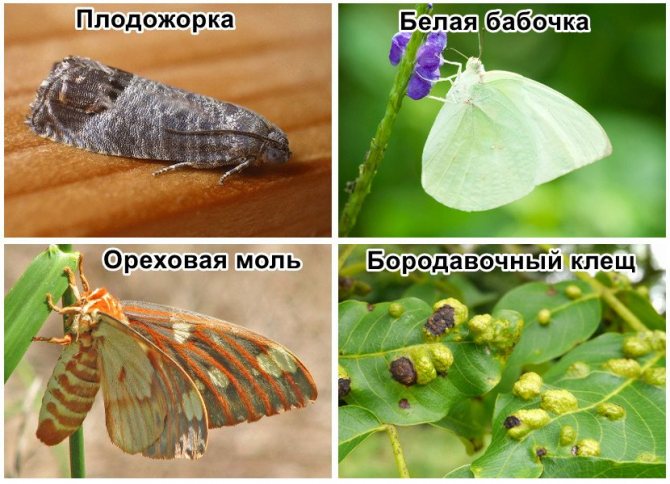

To determine the presence of walnut moth, it is enough to look at the foliage. There should be small dark bumps on its surface. Lepidocide is used against the parasite (100 g per 4 l of water). If dark bumps, similar to warts, appear on young leaves, then the tree is affected by a tick. It is advisable to use a solution of "Bitoxibacillin" against it (200 g per 10 liters of water).
So, now you know how the walnut blooms and develops. It is not difficult to grow it if you adhere to all the basic rules of care. The more effort you put into the development of your culture, the more likely you are to get a quality crop.

